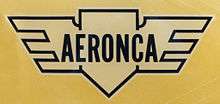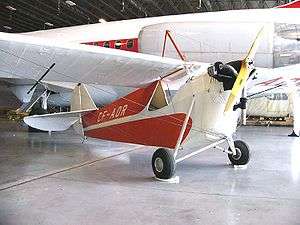Aeronca Aircraft
 The Aeronca logo was usually found on the vertical stabilizer of Aeronca Champs. | |
| Operating Division | |
| Industry | Commercial Aviation and Defense Industry |
| Founded | 1928 |
| Headquarters | Middletown, Ohio |
Key people | Taylor Stanley, Conrad Dietz |
| Parent | Magellan Aerospace |
| Website | aeroncainc.com |
Aeronca, contracted from Aeronautical Corporation of America, located in Middletown, Ohio, is a US manufacturer of engine components and airframe structures for commercial aviation and the defense industry, and a former aircraft manufacturer. From 1928 to 1951, the company was a major producer of general aviation aircraft, and also produced the engines for some of their early designs.[1] [2]
Aeronca is now (2011) a division of Magellan Aerospace, producing aircraft, missile, and space vehicle components at the same location adjacent to Middletown’s Hook Field Municipal Airport.
History
Origins
The Aeronca Aircraft Corporation was founded November 11, 1928 in Cincinnati, Ohio. Backed by the financial and political support of the prominent Taft family and future Ohio senator Robert A. Taft who was one of the firm's directors, Aeronca became the first company to build a commercially successful general aviation aircraft.[3] When production ended in 1951, Aeronca had sold 17,408 aircraft in 55 models.

Production began with the Jean A. Roche-designed Aeronca C-2 monoplane, often called the "Flying Bathtub", in 1929. The next major model was the Scout of 1937, a two-seater, which was developed into the Chief and Super Chief the next year.
In 1937 there was a major flood at the Lunken Airport, resulting in the entire airport area being washed away. Aeronca's factory was destroyed, along with the tooling and almost all of the very early blueprints and drawings. At this time a decision was made to move the operation to a more stable area. Middletown, Ohio was chosen, and the company has remained there ever since.[1][2] All of the airplanes produced from the start of production in 1929 to 1937 are known as the "Lunken" Aeroncas. The first Aeronca built in Middletown was produced on June 5, 1940, and after this time all Aeroncas were built here.
World War II
The Defender, a tandem trainer version of the Chief with a higher rear seat, was used in training many of the pilots who flew i World War II. [1] [2]
Several observation and liaison aircraft designs were also produced during and after the war, seeing extensive front line use, including the L-3, L-16 and O-58. [1] [2]
A glider-trainer version of the Defender, the Aeronca TG-5, replaced the engine with a third seat, facilitating the training of combat glider pilots destined to fly larger craft, such as the Waco CG-4A. [1] [2]
Aeronca's World War II designs—the Defender, TG-5 and L-3 variants—differed significantly from nearly all previous and subsequent Aeroncas by replacing Aeronca's traditional three-longeron, triangular-cross-section fuselage with a four-longeron, rectangular-cross-section fuselage for additional strength. [1] [2]
Postwar

In 1945, following the end of World War II, Aeronca returned to civilian production with two new models, the 7AC Champion and the 11AC Chief. While the Champ shared its tandem seating arrangement with the prewar tandem trainer—and the Chief shared its name and seating arrangement with the prewar Chief designs—both were new designs, and very similar to each other. [1] [2] [4] [5] [6]

A benefit of the concurrent development was that the new designs had about 80% of their parts in common. Nevertheless, the tandem-seat Champ—resembling the extremely popular Piper J-3 Cub—was favored by the market, evidenced by its outselling its sibling, the Chief, at a rate of 4 to 1. Between 1945 and 1951, nearly 8,000 Champions were manufactured (becoming one of the most popular light planes of all time); while over the same period, approximately 2,000 Chiefs were produced. [1] [2] [4] [5] [6]
New ownership
Aeronca ceased light aircraft production in 1951, and in 1954 sold the Champion design to the new Champion Aircraft Corporation of Osceola, Wisconsin, which continued building variants of the Champion as well as the derivative design, the Citabria. The venerable aircraft design was acquired again by the Bellanca Aircraft Company in 1970 and again to American Champion in 1988, where it remains in production.[1][2]
In the early 1970s, Aeronca was contracted by Bede Aircraft to assemble its first Bede BD-5J Microjet—the world's smallest jet airplane—but, after its experiences with the prototype, Aeronca declined to be further involved with the program.[1][2]
In 1978 Aeronca planned to start aircraft production again with production of a prototype very light business jet, the Foxjet ST600. The project was eventually cancelled due to lack of WR-44 engine availability.[7]
Aeronca now builds components for aerospace companies including Boeing, Northrop Grumman, Lockheed and Airbus. In its 23-year history as a general aviation and military aviation manufacturer, Aeronca produced 17,408 aircraft spanning 55 different models.
Aircraft
Date of first production is given
- Aeronca C-4- A cabin biplane design proposed by Aeronca manager Conrad Dietz. Concept rejected in favor of the C-2.[3]
- Aeronca "flying bathtub" family:
- Aeronca C-2 - 1929 single-engine single-seat tube-and-fabric high-wing monoplane with tailskid
- Aeronca C-1 Cadet - 1931 single-engine single-seat light sports aircraft—roughly a C-2 with a C-3 engine.
- Aeronca C-3 - 1931 two-seat (side-by-side) development of Aeronca C-2
- Aeronca C-100 - 1931 English-built variation of Aeronca C-3
- Aeronca L - 1935 single-engine two-seat (side-by-side) low-wing monoplane with conventional tailwheel landing gear
- Aeronca Chief family - prewar:
- Aeronca K - 1937 single-engine two-seat high-wing monoplane with conventional tailwheel landing gear
- Aeronca 50 Chief - 1938 single-engine two-seat (side-by-side) high-wing monoplane with conventional tailwheel landing gear and 50 hp engine
- Aeronca 65 Super Chief - 1938 Aeronca Chief with 65 hp engine
- Aeronca World War II military family:
- Aeronca Defender - 1938 single-engine two-seat (tandem) high-wing monoplane with conventional tailwheel landing gear - soloed from rear seat - precursor to the 7 Champion
- Aeronca L-3 - 1941 military version of Aeronca Champ
- Aeronca TG-5 - 1942 Army glider trainer based on L-3 structure
- Aeronca LNR - 1942 US Navy designation for Aeronca TG-5
- Aeronca L-16 - 1944 military liaison aircraft; basis of Aeronca 7 Champ
- Aeronca 7 Champion ("Champ") - 1945 single-engine two-seat (tandem) high-wing monoplane conventional tailwheel landing gear - soloed from front seat
- Aeronca 9 Arrow - 1947 single-engine two-seat low-wing monoplane with retractable landing gear. One built; not put into production
- Aeronca 11 Chief - 1945 new design but similar to the pre-war Chief but with a wider cabin and different wing
- Aeronca 12 Chum -(1946) Aeronca's competitor to the Ercoupe. Two prototypes built; not put into production [8]
- Aeronca 15 Sedan - 1947 four-seat aircraft with fabric-covered fuselage and full metal wings
Missiles
Engines
Museum Displays
- exhibits pending (now in restoration at Brighton Airport)
- 1936 Aeronca C-3 Master
- 1937 Aeronca Model "K"
See also
References
- 1 2 3 4 5 6 7 8 9 10 Harris, Richard, "Aeronca: Birth of the Personal Plane," AAHS Journal, Summer 2007, vol.52, #2, American Aviation Historical Society
- 1 2 3 4 5 6 7 8 9 10 Harris, Richard, "Aeronca/Champion History: Beyond the Bathtub -- Chiefs, Champs & Citabrias," from articles by Richard Harris first appearing in In Flight USA, 2003-2004, condensed on author's website.
- 1 2 Donald M. Pattillo. A History in the Making: 80 Turbulent Years in the American General Aviation Industry. p. 18.
- 1 2 Karant, Max, "Flying Check Pilot: The Aeronca Chief," 'Flying Magazine, Dec., 1946.
- 1 2 Sargent, Sparky Barnes, "A Honey of a Champion!: The Baker family’s award-winning Aeronca," Vintage Airplane, Dec., 2007, vol.35, #12, Experimental Aircraft Assn.
- 1 2 Keyhoe, Donald E., Major, USAF (noted USAF test pilot), "Plane of the Month: The Aeronca Chief," TRUE: The Men's Magazine, Sep., 1946.
- ↑ "Aeronca to Build Foxjet". Flight International: 230. 28 January 1978. Retrieved 2008-03-27.
- ↑ Alan Abel, Drina Welch Able and Paul Matt. Aeronca's Golden Age. p. 135.
- "Aeronautical Corporation of America (Aeronca)" by Roger Guillemette, US Centennial of Flight Commission, retrieved 20 January 2006.
External links
| Wikimedia Commons has media related to Aeronca. |
- Aeronca Aviators Club, started by Joe Dickey. Has Quarterly Newsletter
- National Aeronca Association, associated with the original Aeronca factory.
- Aeronca Aircraft History Museum, Director Todd Trainor, supporting various models of the aircraft.
- Aeronca Club of Germany
- Aeronca Club of Great Britain
- Fearless Aeronca Aviators, a very popular Aeronca email list.